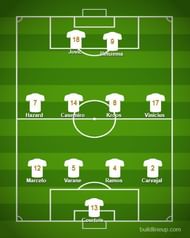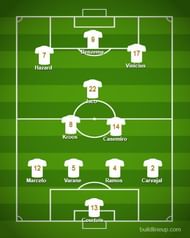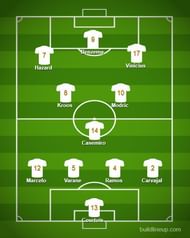
Real Madrid's woeful underperformance last season had the concordant effect of full-scale changes at the club.
The first of those modulations came about in the dugout, as Zinedine Zidane was reappointed in Solari's stead barely four months into the Argentine's tenure and less than 10 months since Zidane himself vacated the post.
One of the first things the Frenchman promised was a comprehensive overhaul of the squad and so far, the 46-year-old has kept good to his word, as no fewer than five new players have arrived the Bernabeu for the combined sum of £272m while four players have departed permanently with four going out on loan and more expected to follow in the coming days.
Most of the modulations have been made in defense and attack, which addresses two problems the club faced last season viz: not scoring enough goals and conceding too many.
Real Madrid's midfield has remained virtually untouched, with the key men still expected to play a starring role once again next season.
Himself a former midfielder, Zidane knows too well the importance of a functional midfield, as it is through this department that most of the implementation of tactical drills is carried out.
Heading into the new season, Zizou would attempt to get the right balance in the middle of the park. In this piece, we shall be dissecting what Real Madrid's likely midfield combinations for next season would be, and the accordant pros and cons associated with each
#1 Flat four in the middle

In the not too distant past, it was a very common feat to see managers line up with four men in midfield, with two central midfielders holding the base, while traditional wingers bombarded down the flanks to deliver crosses to their two mostly stationary forwards.
The rise of inverted wingers like Arjen Robben and Cristiano Ronaldo who drifted in onto their stronger foot to shoot at goal in the middle of the last decade reduced the effectiveness of more traditional wingers like Ryan Giggs and Aaron Lennon.
Barcelona's unprecedented success with their immaculate trio in midfield consisting of Xavi, Iniesta, and Busquets under Guardiola virtually sent the 4-4-2 system into extinction, with most modern managers (Zidane included) playing with three in the middle.
However, the arrival of Luka Jovic from Frankfurt presents a tactical conundrum for Zinedine Zidane.
The 21-year-old had his breakout campaign last season where he scored 27 goals to court the attention of Europe's top clubs.
Luka Jovic is a dynamic forward who can play anywhere across the frontline, but thrived best when he was deployed just behind Sebastian Haller at Frankfurt, as his excellent hold up and link up play made him an excellent asset to manager Adi Hutter and the fact that Jovic arrived for €60m means that the Serbian international is likely going to get game time.
To date, Zidane's preferred attacking system has seen him operate with one central striker, but doing so would come at the expense of either Karim Benzema or Luka Jovic.
However, both men are extremely suited to a two striker system and this suitability could lead to a major tactical deviation from Zidane.
He could well decide to play both men upfront and this would have an effect on his midfield, as he would have four men in the middle as opposed to the three associated with him throughout his managerial career.
We got a chance to see the workability of this system in the friendly fixture with Arsenal when Zidane started with a 4-4-2, but Nacho's early red card forced his manager into a tactical switch.
In a 4-4-2 formation, Eden Hazard would have to drop deeper to occupy a left-wing midfield berth while Vinicius would complement him on the other wing.
The game against Arsenal saw Zidane make a surprise addition to his midfield, as Lucas Vazquez was started on the right flank of midfield and the reason for this is not far fetched, as the 28-year-old has a high work ethic and can provide extra cover for the defense.
An advantage to this system is that it would play to the strengths of Real Madrid's two main strikers, while a drawback is that it limits the creativity of other forwards like Eden Hazard and Vinicius Jr.
# 2 The double-pivot system

This is the tactical variation most favored by managers in the current game, as it provides stability in defense while giving forwards the freedom to unleash their attacking prowess without having to worry too much about defensive exposure.
This system would effectively be a 4-2-1-3, with Toni Kroos and Casemiro acting as the shield to the defense, while Isco occupies the hole behind the front three.
The latter is a firm favorite of Zinedine Zidane and would most likely get a lot of playing time (if he does not leave) and this system is best suited to his creative abilities, rather than instances when he was forced to play out wide.
It would also see Eden Hazard and Vinicius deployed in their more natural positions further forward (although the Brazilian would have to play on the right) but would come at the expense of one of Karim Benzema or Luka Jovic.
#3 The tested and trusted trio

A keen observer would have noticed that in each of the two preceding systems in this piece, there was no space for the current best player in the world; Luka Modric.
The Croatian international has been nothing short of exceptional since arriving at Real Madrid in the summer of 2012 and his time at the Bernabeu has seen him win everything winnable at club level.
However, the cold fact of the matter is that at 34, Luka Modric is no longer the player he was and evidence of this was recorded last season.
Nevertheless, the former Tottenham man was an integral member of the most successful period in Real Madrid's recent history under Zidane and he played an integral role in the middle of the park alongside Casemiro and Toni Kroos.
So far in his coaching career, Zinedine Zidane has shown a fierce loyalty to the players he believes in and it could well be a case of tested and trusted' for the 46-year-old in the middle, with the only changes from his treble Champions League winning team being Eden Hazard for Cristiano Ronaldo, Courtois for Navas and Vinicius for Bale.
In this system, Casemiro would be tasked with doing what he does best: breaking up opposition play and winning back possession while Kroos would be in charge of distribution and Modric the link between midfield and attack.
After all said and done, each of these highlighted formations all have their usefulness and the performance levels of the current Real Madrid midfielders mean that they are all feasible.
Zidane would most likely deploy all these midfield systems at one point or the other during the course of the long campaign and his hope would be that his midfielders can step up to the levels expected of them.
